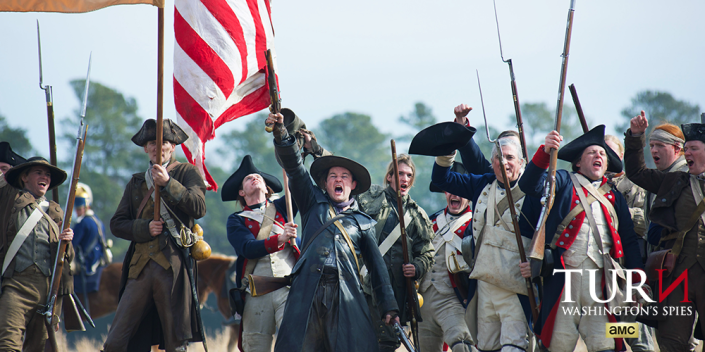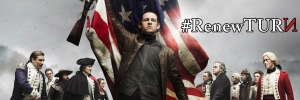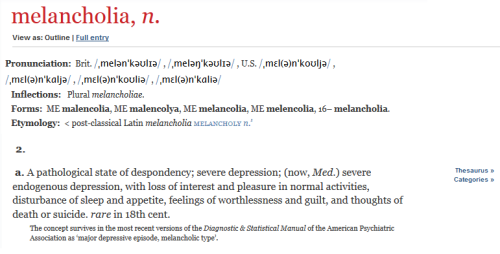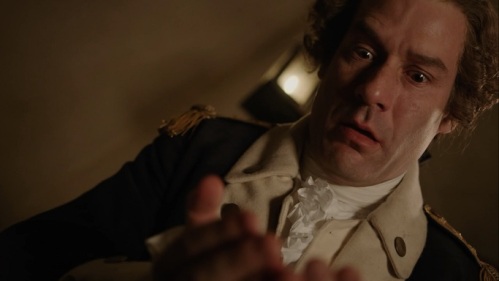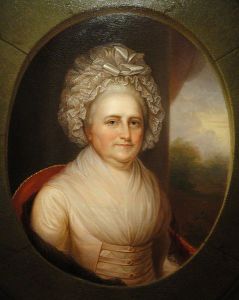TURN Historical Timeline updated for Season 4 (Part One)
As the TURN: Washington’s Spies storyline hurls itself toward the end of the Revolutionary War, its writers seem determined to name-drop as many minor characters and events as they can in the show’s final episodes. (Perhaps they’re making up for lost time, as one of the most common viewer complaints about Season 1 was that it didn’t contain enough espionage or war-related action).
As a result, the Historical Timeline is bigger than ever — with ample room for the tsunami of names and dates that the last two episodes of the series are sure to generate. Even though there’s only two episodes left, there’s a lot of ground to cover if the writers plan to wrap up the stories of all the characters tied to the Culper Ring — so, who knows? The next Timeline update might be even larger than this one!
All “new” events — that is, all events referenced in Season 4 thus far — are in green text. Click on the image below to enlarge. You can also visit the blog’s Timeline page to see a chronological list of all events shown on the Timeline with plenty of links to further reading. As always, if there’s an event that is referenced in the show that you don’t see on the Timeline, let me know and I’ll add it in during the next update!
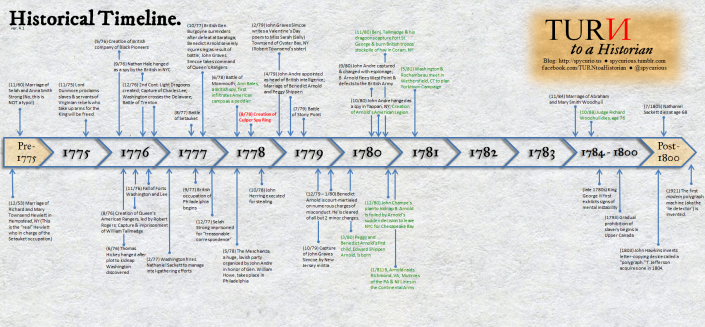
In general, there’s been less deviation from historical chronology in Season 4 of TURN than there has been in the previous three seasons. Some notable differences between TURN and the factual historical timeline include:
- Peggy and Benedict Arnold’s first child was born in March 1780, meaning that Peggy was nursing a six-month-old infant at the time Benedict fled West Point after his treason was discovered.
- Ann Bates was active as a spy (as a peddler in disguise) from June 1778 through May 1780 — a full year before Washington and Rochambeau began planning the Yorktown Campaign.
- For a nice recap of how TURN combined elements of both the Pennsylvania and New Jersey Line mutinies, which were technically two separate events that took place in January 1780, read J.L. Bell’s review of Season 4 Episode 4, “Nightmare.”
- Just like poor Nathaniel Sackett, Judge Woodhull was killed off long before his time in the fictional universe of TURN. Happily, he not only survived the Revolutionary War, but lived long enough to see his son Abraham get married (which also happened after the war was over).
And with that, it’s off to the races as the penultimate episode airs later tonight (9:00pm Eastern time). See you on Twitter tonight, TURNcoats! And don’t worry — although the crazy summer schedule of Season 4 has thrown off the regular posting rhythm ’round these parts, the blog posts and updates will keep rolling out long after the August 12th finale, so stick around!
-RS
TURN Season 4 Premiere and Link Roundup
Greetings, TURNcoats! It’s finally here – June 17th, 2017 – the premiere of the fourth and final season of TURN: Washington’s Spies! (It also happens to be the anniversary of the 1775 Battle of Bunker Hill, for all you devoted Revolutionary War fans.)
Tonight’s premiere will be a jam-packed two-hour event that deals, first and foremost, with the fallout of Benedict Arnold’s betrayal at West Point (the subject of Season 3’s dramatic finale). Like all the episodes before it, the premiere is sure to generate plenty of dubious historical claims to assess, dates to plot on the historical timeline, and questions to ask your friendly neighborhood historian(s). I’ll be live-tweeting tonight’s premiere, along with a whole bunch of die-hard fans as well as cast members. Follow @spycurious and the hashtag #TURNamc!
Season 4 Premiere Link Roundup:
If you didn’t have ten hours to devote to re-watching Season 3 of TURN, I’d recommend browsing through the library of individual episode reviews at Den of Geek, written by the always-thorough J. L. Bell of Boston 1775 fame.
USA Today also has a short article about the Season 4 premiere, which (unintentionally) underscores TURN’s gravely inaccurate portrayal of John Graves Simcoe by describing him as “a sociopath with a talent for military strategy who has a personal ax to grind with several of those rebel spies.” As we’ve discussed here in great detail over the past three years, Simcoe is, hands-down, one of the most completely inaccurate and misrepresented historical figures in the entire show. The real John Graves Simcoe, while a fearsome officer in battle, was nothing like the unhinged brute viewers see when they tune into TURN. In addition to our backlog of blog entries here, T. Cole Jones, professor of history at Purdue University, goes into even greater detail about TURN’s misrepresentation of Simcoe in this Common-place Journal article from 2015 which is a must-read for any fan interested in the accuracy of both TURN and the book that inspired it.
Ross Nedervelt at FIU is the latest history academic to pen a review of TURN: Washington’s Spies, this time at the British Society for Eighteenth-Century Studies. While he is more charitable than most other historians have been towards the show, he does point out a number of pet peeves that we share here at the blog (e.g. glaring biographical inaccuracies, the depiction of Simcoe as a psychopath, Caleb Brewster’s anachronistic speech patterns, etc.).
What to make of TURN’s dramatically different Saturday evening time slot? In 2016, AMC “burned off” the final season of Hell on Wheels in the Saturday night timeslot and it looks like they’re giving TURN the same treatment this year – assuming in both cases that devoted fans will tune in to watch the show live, while everyone else will record and watch the episodes later. Indeed, the overwhelming majority of TURN’s audience numbers come from streaming services and DVR viewings – the live numbers for the show have taken a precipitous drop with each successive season. (For example, the Season 1 premiere had 2.12 million viewers; Season 2 had 827,000 viewers; Season 3 had 471,000. You can view live viewing numbers for each episode here.)
The upside is that the showrunners had long known that Season 4 would be TURN’s final season, so they were able to craft the entire season without worrying about potential numbers and ratings at all. At the same time, they’ve got quite a lot of ground to cover in a mere ten episodes.
Historically speaking, unlike the Continental Army at large, the Culper Spy Ring was incredibly active during the final years of the Revolutionary War, even after the surrender of British forces at Yorktown in 1781. Benjamin Tallmadge and the 2nd Dragoons were especially vigilant, leading a number of dramatic shoreline raids across Long Island Sound against British and Loyalist-held strongholds. After the West Point fiasco, Benedict Arnold was quite eager to prove his loyalty to the British by, among other things, raiding and burning a number of prominent American towns – including New London, Connecticut, just a few miles south of his boyhood home of Norwich. (Pretty harsh, Benedict. No wonder New Londoners are still burning you in effigy well into the 21st century!)
As a native Connectican with a professional interest in Connecticut history, imagine my excitement when on-set photos leaked of Owain Yeoman appearing to invade and burn a colonial city with a regiment of British regulars! Alas, according to this in-depth interview with showrunner Craig Silverstein at Entertainment Weekly, the photos likely depicted Arnold’s raid on Richmond, Virginia… not the Connecticut coast. (sigh.) Regardless of my parochial disappointment, the EW interview with Silverstein is incredibly thorough and well worth the read for any TURN fan eager to catch a glimpse of what Season 4 might contain.
How about that slick Season 4 artwork, TURNcoats? Have to admit – I’m a huge fan. (MUCH better than the bizarre, anachronistic, politically-driven marketing campaign of Season 3, which awkwardly tried to compare George Washington’s political views to those of Hilary Clinton, Donald Trump, and Bernie Sanders, and produced many a cringe-worthy gif. Remember that?) If year-over-year improvement is any indication, this season’s graphic artist should get a raise.
Finally, if you’re new to the TURN to a Historian blog: Welcome! Our Topic Index page is a great place to get started in regards to browsing all the historical topics we’ve covered on this blog thus far. If you have a specific question, fire away on the Ask a Question page. In the meantime, pull up a chair and enjoy the two-hour premiere. See you on the flip side!
-RS
TURN Historical Timeline updated for Season 3
Still reeling from this week’s Season 3 finale? How about a healthy dose of TURN-related history? We’ve updated the Historical Timeline with events mentioned and/or depicted in TURN Season 3. In a slight change from previous timeline updates, all the Season 3 events are labeled with dark green text, to more easily distinguish this seasons’ additions from the events mentioned in Seasons 1 and 2. While the timeline itself is embedded below, don’t forget to visit the full Historical Timeline page for a chronological listing of events, including external links to relevant history websites. Enjoy!

There’s no doubt that Season 3 of TURN began slowly, and with very few connections to actual historical events (see our previous post lamenting this fact). Evidently the writers were saving all of the spy action and historical precedent for the last few episodes, which drew heavily upon the well-documented Andre-Arnold affair of late 1780.
Most of the new timeline events deal with Benedict Arnold, since a large part of Season 3 revolved around the dramatic buildup of his infamous defection — and John Andre, who ends up paying the steepest price for Arnold’s actions. You’ll see Arnold’s court-martial, defection, and marriage to Peggy Shippen all plotted on the updated timeline.
Another event that was prominently (if very briefly) mentioned in the Season 3 finale was the execution of Nathan Hale — an event that was first mentioned in TURN Season 1 and has been on the Timeline ever since. For some bizarre reason, the show announces Hale’s execution date as October 22, 1776, instead of September 22 — a bizarre and seemingly unnecessary factual error that provides no benefit for the show’s storyline development. It’s no surprise that a Hollywood history show deviates from a 100% perfect chronological unfolding of historical events, of course — that’s why we made the Timeline in the first place! Some deviations, however, are much easier to explain than others.
Think there’s a historical event missing from the Timeline? Is there some ingenious reasoning I’ve missed behind TURN moving a semi-obscure historical date around by a mere 30 days? Leave a comment below (or tweet me, or email via the Ask page) and let me know!
-RS
TURN Season 3: All Quiet on the History Front?
Greetings, TURNcoats! How about a nice link roundup to compliment the first two episodes of Season 3?
Here we are, technically 1/5 of the way into Season 3, and things have been suspiciously quiet over here at the blog. Sure, we’ve had a blast live-tweeting every episode, but no new articles here at the blog. What gives?

Well, to be honest, there hasn’t been a whole lot of actual historical stuff happening in TURN Season 3 thus far. As a historian watching the show, there’s very little fact-based material to capitalize on, aside from a few name drops (e.g. Joseph Reed, Austin Roe) that don’t yet have enough context in the show to merit a full-length analysis. Nearly all of the first two episodes have revolved around made-up love triangles, fictional family feuds, and other interpersonal relationships that never happened.
Thankfully, we have covered most of those subjects in previous posts – so while we wait for some meatier historical topics to arrive in Season 3, here’s a quick and dirty link roundup for those of you trying to sort fact from fiction regarding all the personal drama in the TURNiverse:
- Abe and Anna: Never happened. (Although thus far in Season 3, their fictional affair seems to have cooled considerably.)
- Abe and Robert Rogers: An amusing (if bizarre) premise – but this also never happened. For more about the real Robert Rogers’ wartime escapades, check out Todd Braisted’s excellent summary here.
- Anna and Hewlett: Never happened. Although if you’re interested in the real Hewlett’s role in occupying the town of Setuaket, we’ve got you covered. We featured an article on the historical Hewlett in the middle of Season 2, right before TURN’s Hewlett dramatically veered away from the (until that time) realistic portrayal of his real-life counterpart.
If you’re a little confused from the “authentic” messaging you’ve been hearing from AMC staff regarding Hewlett – no, you’re not crazy! On Twitter and Reddit, Alexander Rose (who joined the show’s writing staff in Season 2) has repeatedly insisted that TURN’s Edmund Hewlett, the royalist commander of Setuaket during the Revolutionary War, has absolutely no connection whatsoever to the historical Richard Hewlett, the royalist commander of Setauket during the Revolutionary War. It is a total and complete coincidence that both men held the exact same station, at the same time and in the same place, and had the last name “Hewlett.”

Needless to say, viewers of the show are right to be a little skeptical. By that logic, of course Anna Strong could never have had an affair with a fictional Redcoat officer! Not to mention, the real Anna Strong was still (by any reasonable account) contentedly married and the mother to several children by the time the summer of 1778 rolled around, so there’s that, too.
- Austin Roe: Okay, Austin Roe DID happen! He was a real person (definitely not anyone’s pseudonym or alias) and, for a time, an absolutely fascinating member of the historical Culper spy ring who served as the vital link communicating intelligence between New York City and Setauket. I’m seriously hoping the one mention he’s had thus far in Season 3 is some kind of bizarre red herring and/or bad history joke – it would truly be a shame for him to be cut out of this series, regardless of how much the show has already careened off the historical record. We will definitely revisit Mr. Roe here on the blog – after we get a better idea of where the show is going to take him.
- Woodhull family drama (especially concerning Mary and Thomas): Never happened. Thankfully,
we’ve got a post on TURN’s convoluted family trees to help viewers sort things out! - Peggy Shippen and Benedict Arnold: Oh yes, this happened – although as many of you likely guessed, it wasn’t exactly the bizarre love triangle with ulterior motives depicted in TURN. We’re in the process of reaching out to a few exciting guest authors for this particular topic, so stay tuned!

- Blood-spattered John Graves Simcoe: Well, it looks like TURN’s “Psycho Simcoe” portrayal isn’t going anywhere this season! Only two episodes into the season and we’ve seen plenty of Simcoe-generated ketchup. If you’re only familiar with Simcoe through what you’ve seen in TURN, you may be in for a bit of a shock once you read a little bit about the real Queen’s Ranger commander by that name! Thankfully, Todd Braisted has not one but two excellent articles about the real Simcoe: one about Simcoe’s captivity at the hands of the Continental Army (as loosely portrayed in Season 1) and another about his tenure as leader of the Queen’s Rangers (TURN Season 2 and beyond). At the TURN roundtable on Common-place.org, guest author and Purdue University history professor T. Cole Jones also analyzes the many liberties TURN takes with John Graves Simcoe.
Well, I think that just about does it for tonight’s link roundup. Plenty of reading to re-visit while we wait for bigger and better spy-related history to materialize in TURN Season 3. Enjoy tonight’s new episode, TURNcoats – and if you’re watching live, don’t forget to join in the fun on Twitter and Facebook!
-RS
Introducing the “Topic Index” page (Just in time for the Season 3 Premiere!)
Greetings, TURNcoats! The premiere of Season 3 of “TURN: Washington’s Spies” is upon us — only a few hours away at the time of this posting. First, we’d like to welcome back blog readers both new and old! If you’re new to TURN, or just finishing re-watching Seasons 1 & 2 in anticipation of tonight’s premiere, you probably have a whole bunch of historical questions. We understand. In general, TURN takes a whole lot of liberties with the historical record — to the point where reading real history books won’t help you predict where the show is going to go!
Of course, this blog is here to help with your historical accuracy questions. And now we’re making it a little easier to find the answers you’re looking for with our new Topic Index page, which now happily occupies its own little tab in the header menu at the top of our website. Yes, you can always search the archives of the blog like you have before — by date of posting, by using the search bar, or via tag cloud (all located in the sidebar on the right side of every page). Still, we thought it would make things a little easier to have a general subject listing, especially for those who are new to the blog. Our most popular posts are sorted both by topic (e.g. Revolutionary War spycraft, slavery, material culture) and by character. Let us know what you think — and happy reading!
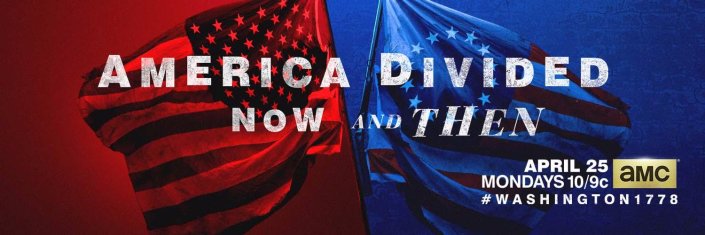
Finally: If you’re watching the premiere live tonight, don’t forget to join us for live-tweeting and Facebook commenting! We use the standard #TURNamc hashtag on Twitter to tag most of our posts. We already know from the Season 3 previews that Alexander Hamilton — who is definitely America’s trendiest Founding Father at the moment — will grace our televisions this season. But are the swirling rumors true about Martha Washington and Nathan Hale making cameos? And will any of them even remotely resemble their real-life historical counterparts? We can’t wait to find out. Stay tuned, and grab the popcorn! (Or some other tasty 18th century recipe, if you feel so inclined.)
-RS
http://facebook.com/TURNtoahistorian
http://twitter.com/spycurious
Spy Chat in Fairfield: Revolutionary Spies in CT (Featuring Caleb Brewster and the Whaleboat Wars)
(Edit: No, “Caleb Brewster and the Whaleboat Wars” isn’t the name of a band. But it SHOULD be.)
Happy new year, TURNcoats! The Season 3 premiere is only a few weeks away. Ahh, such anticipation. So much writing and previous-episode-binge-watching to do, and so little time! (Not to mention: So many “Ask a Question” queries to answer! We’re working on the backlog. 491!)
Hopefully you’ve been keeping your new-episode-anticipation in check over the past several months. AMC’s social media hype machine is now in full swing, and we’re dedicating an upcoming post to dissecting all the new official TURN hashtags (e.g. #washington1778), trailers, promo pics, and more. And to all our followers who joined during our inter-season hiatus: Greetings and welcome! You can browse the blog archives for Season 1 and 2 using the calendar in the right sidebar. Have a question or suggestion for an upcoming blog topic? Let us know!
Here at the blog, we’re kick-starting the new season hype with a bang, at a TURN-themed event at the Fairfield Museum and History Center in Fairfield, CT!
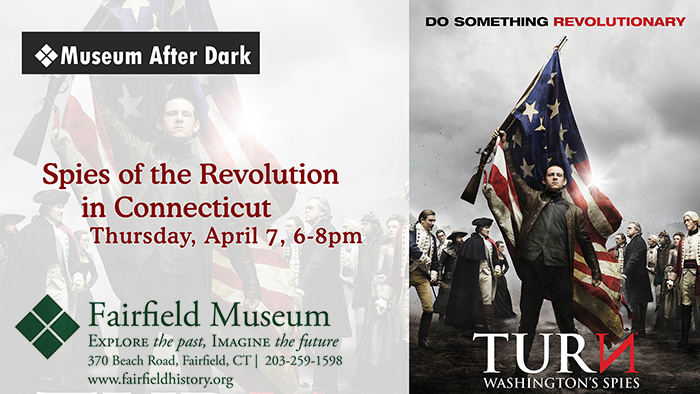
I’ll be giving a general overview of TURN’s accuracies and inaccuracies and chatting about Connecticut’s central role in Revolutionary War espionage; Robert Foley of Black Rock Historical Society will be talking about the REAL Caleb Brewster (who settled in the Fairfield/Bridgeport area after war’s end) and the Caleb Brewster Digital Humanities Project; and Jackson Kuhl, author of Samuel Smedley, Connecticut Privateer, will talk about the many coastal raids of Long Island Sound that took place during the war.
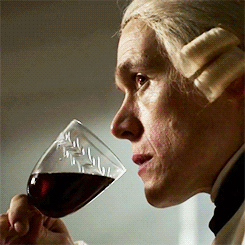
If you’re a TURN fan within driving distance of Fairfield County, CT, come join the fun! Plenty of the historical activities of the Culper Ring that (loosely) inspired TURN took place in or near Fairfield County, and Caleb Brewster’s a local hero ‘round these parts. (We’ve already touched upon the anachronistic language, mannerisms, and outfits of TURN’s highly-fictionalized Caleb Brewster, but there’s a whole lot more to the real-life historical figure than mere proper 18th-century dress!)
This talk is part of Fairfield Museum’s “Museum After Dark” program, which features informal panel-type discussions, wine and cheese, and plenty of stimulating, informed conversation. Free for museum members; $5 for non-members.
Interested? Meet us at gnu fiegh lh, jecljcimh 735. (Or you could simply check out the Museum After Dark event site for more details.)
-RS
New Scholarly Roundtable on Historical Accuracy vs. “Truth” in TURN
Academia finally joins the conversation about TURN! The newest issue of Common-place, an online scholarly journal of Early American life and culture, just launched yesterday — and it features a Roundtable discussion about historical accuracy in TV and film, using TURN: Washington’s Spies as a case study. Don’t let the “scholarly journal” part scare you off — the two main articles in this Roundtable are spirited and highly-readable commentary pieces that are must-reads for any serious fan — or critic — of TURN.
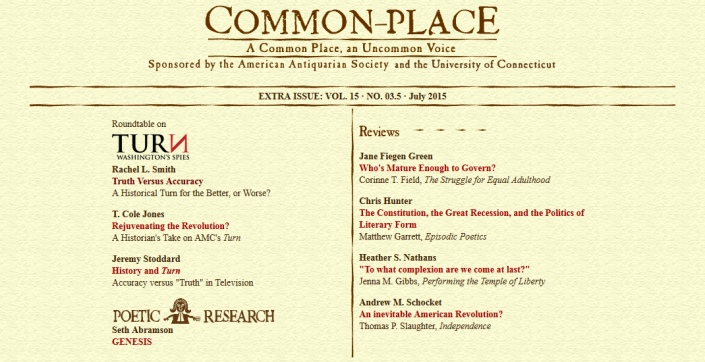
Back in February of this year, we mentioned a most unlikely meeting of the minds at the College of William & Mary, where TURN producers, writers, and cast members gathered onstage alongside William & Mary professors to discuss the role and importance of historical accuracy in film. Happily, footage of the entire 90 minute event was released on Youtube in May, with shorter highlights posted in a William & Mary press release (in case you don’t have an hour and a half to spare).
This new issue of Common-place continues that incredibly important conversation, featuring some names that might be familiar to readers of this blog. To kick things off, I wrote the brief introduction to the Roundtable, framing the debate’s central questions:
- Do the virtues of inaccurate historical films outweigh their vices?
- How much weight should accuracy have in our evaluation of historical film?
- Most importantly, are there historical narrative truths that supersede factual accuracy?
To devoted students of history, that last question might sound silly, if not completely ridiculous — after all, if facts don’t matter, then what does? But it’s a question that more and more people these days — including the writers and producers of TURN — are answering with a resounding “YES.”
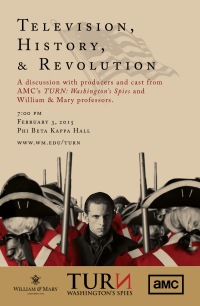
Jeremy Stoddard, a professor of education and film studies, gives TV and film writers the benefit of the doubt, arguing that fictional historical narratives DO have value (that is, beyond the monetary sort), referencing his own quest to learn more about Robert Rogers after watching the TURN series premiere. Stoddard, who attended the William & Mary event in person, gives readers a thoroughly detailed summary of the arguments given by TURN’s writers, producers, and other staff (e.g. the costumer) for why they deviated from the historical record in the way that they did. Read Jeremy Stoddard’s Roundtable article here.
On the other end of the debate, T. Cole Jones explains why he finds TURN’s blatant disregard for historical fact extremely problematic. Longtime readers of this blog are already familiar with Dr. Jones, who penned an excellent piece analyzing the treatment of prisoners of war in Season 1 of TURN. In his article for Common-place, Jones targets the show’s portrayal of John Graves Simcoe as a murderous sociopath and cartoonish British villain. He doesn’t mince words, arguing that TURN’s “artistic liberties” are so factually untrue they’d “undoubtedly expose the producers to a defamation of character suit were the people portrayed in the series still alive.” According to Jones, a number of TURN’s factual problems can be traced back to the show’s alleged source material: Alexander Rose’s book Washington’s Spies. It’s a solemn reminder that not all history books are created equal. (We’ll be offering our own concurring opinion on this point sometime later in the TURN offseason.) Read Cole Jones’ Roundtable article here.
Like I said, these pieces are must-reads for any serious fan or critic of TURN — or of historical fiction in general. If you have a Disqus account, you can leave comments on the articles themselves, or join the conversation on Twitter.
Finally: It’s incredibly refreshing to see academics engaging this issue in a scholarly forum — and my thanks to the event organizers at William & Mary for providing an excellent icebreaker back in February. Far too many scholars of Early America have asked the same question voiced by certain TURN fans upon finding this blog: So what? Who cares if some TV show is historically accurate or not? Over the past two years, I’ve been stunned — though not entirely surprised — at how many academics have plugged their ears to the debates taking place over historical accuracy in TURN, often dismissing the subject as insufficiently intellectual or otherwise not worth their attention. They couldn’t be more wrong.
Granted, the primary purpose of TV shows is to entertain, not educate. (And make money doing it.) However, as I argue in the introduction I authored for the Roundtable, the question of accuracy in film does matter because, for better or for worse, historical fiction influences popular historical memory. These TV shows and films are affecting how Americans remember their own history. And for that reason, among others, scholars of Early America ought to weigh in on these debates — which, in many cases, are already happening all around them. As we’re seeing with a number of recent events (e.g. the Confederate Flag brouhaha), the intersection of history and memory impacts an awful lot of people. We do the American public a grave disservice if we let the same people who write questionable “history” books — and the shows and films based on them — be the loudest voices in the conversation.
Check out a 60-second video preview of the new Common-place issue below:
(Note, Jan. 2016: Last year, a few months after the TURN Roundtable was published, Common-place unveiled a brand-new look and a more modern, streamlined format. Eventually, the TURN Roundtable articles will be migrated over to the new journal format, along with the rest of Common-place’s back issues – but until then, they can be found at common-place-archives.org. All the links in this post have been updated to reflect this change. Enjoy!)
-RLS








